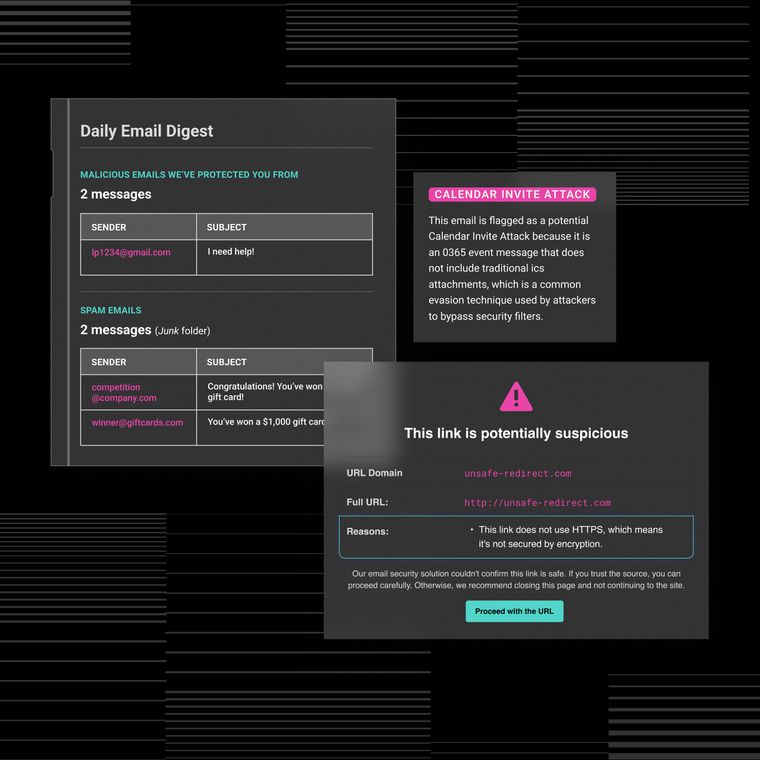How Behavioral AI and Cybersecurity Work Together
Explore how behavioral AI enhances cybersecurity by improving detection and response.
October 15, 2025
Traditional security controls provide essential foundations while behavioral AI delivers the adaptive intelligence needed to combat modern threats. This combination creates a comprehensive defense.
Security controls establish guardrails through multifactor authentication, encryption, and access management while behavioral AI continuously verifies every interaction against learned baselines, catching anomalies that static rules miss.
This hybrid approach creates defense systems that scale with the sophistication of attacks, transforming reactive security into proactive threat prevention. Let’s learn how exactly these two approaches strengthen each other.
Going Beyond Rules and Signatures
Legacy security tools depend on static rules and signatures that cannot handle sophisticated threats. Modern attackers employ generative AI for advanced phishing, malware, and social engineering attacks, exposing the limitations of traditional methods.
Rather than abandoning conventional cybersecurity, organizations enhance these methods by integrating adaptive behavioral AI. This fusion allows security systems to evolve alongside threats, offering real-time anomaly detection while reducing false positives. The approach lays the foundation for dynamic cybersecurity strategies that can adapt to unpredictable threats.
Combining traditional guardrails with behavioral intelligence creates adaptive defense systems addressing both current and emerging challenges. Security teams gain visibility into subtle behavioral deviations that signal potential attacks, transforming detection from pattern matching to continuous verification that learns and improves automatically.
Cybersecurity Provides the Guardrails
Cybersecurity controls establish essential foundations that behavioral AI builds upon, not replaces. Identity and access management, paired with multifactor authentication, confirms user access rights, while data-at-rest encryption and microsegmentation keep information confined to trusted zones. Compliance frameworks like NIST translate these practices into auditable policy, ensuring documentation and enforcement.
Integrating AI into existing security programs delivers superior results compared to replacement approaches. Established controls generate rich identity, network, and application telemetry that behavioral AI uses to learn normal patterns and surface genuine anomalies.
Least-privilege policies, data loss prevention rules, and change-management workflows become more effective when AI continuously validates that actions align with historical behavior. Static guardrails block obvious threats; continuous verification catches subtle behavioral deviations that modern attackers exploit. This foundation enables behavioral AI's real-time threat detection capabilities.
Behavioral AI Provides Continuous Verification
Behavioral AI transforms traditional security checkpoints into real-time verification systems that analyze every user, device, and vendor interaction against established baselines. Behavioral models ingest historical signals: login patterns, file access behavior, and communication styles establish normal profiles. When systems detect deviations, they assign risk scores and trigger automated responses.
Executive accounts logging from new geographies after routine sessions (impossible travel) raise immediate flags. Approved suppliers changing payment details outside billing cycles trigger vendor fraud alerts. Urgent wire requests that deviate from typical communication patterns may indicate a potential account compromise.
Self-learning algorithms incorporate analyst feedback without manual rule updates. Behavioral Graph Intelligence maps relationships across email, collaboration, and cloud platforms, surfacing only high-risk deviations. Continuous verification ensures attackers cannot hide behind valid credentials or familiar workflows, uncovering advanced attacks that bypass traditional detection methods.
Closing Gaps That Legacy Tools Can't
Legacy controls miss stealthy, human-focused attacks; behavioral AI surfaces them by spotting activity deviations. Traditional filters expect malware signatures or obvious violations. Attackers rely on subtlety instead, launching campaigns that slip past gateways because nothing appears inherently malicious.
Payload-free phishing relies on persuasive language rather than links or attachments. Account takeover attacks reuse valid credentials, blending with legitimate activity. Vendor compromise scenarios involve trusted partners requesting fraudulent payments. Insider threats arise when employees exfiltrate data using legitimate access rights.
These threats evade static defenses because rules cannot predict novel wording, and signatures cannot flag clean files. Behavioral AI closes gaps by learning granular baselines and then flagging subtle shifts. Organizations expose threats hiding in plain sight, transforming detection from reactive pattern matching to proactive anomaly identification.
Reducing Analyst Fatigue With Intelligent Prioritization
Intelligent prioritization transforms security operations by filtering signal from noise, enabling analysts to focus on genuine threats rather than drowning in false positives. Enterprises generate overwhelming SIEM events daily, creating unsustainable workloads that inflate response times and drive analyst turnover.
Solve this challenge by prioritizing alerts based on behavioral deviations rather than static policy violations. For instance, behavioral AI analyzes historical activity patterns to establish baselines for users, devices, and vendors. When alerts trigger, systems evaluate them against baselines, apply contextual data including identity, geography, and access history, and then assign precise risk scores.
This converts SOCs from alert-processing centers into strategic decision engines, where analysts handle fewer incidents, resolve them faster, and apply expertise where human judgment creates value. Also, it helps teams reclaim capacity for threat hunting and strategic initiatives.
Adapting Together Against AI-Powered Threats
Attackers and defenders operate at machine speed, requiring security stacks that combine fixed guardrails with self-learning behavioral AI. Large language models create convincing spear-phishing emails that trick recipients into clicking malicious links. Botnets scan networks automatically at a massive scale, identifying vulnerabilities faster than humans can respond.
Traditional controls provide essential foundations but cannot spot attacks that look legitimate. Behavioral AI solves this by learning what's normal for each user, device, and vendor, then alerting when something changes. The system improves constantly. When attackers try new tactics, the AI adapts. Organizations share threat insights securely without exposing private data.
Also, confirmed threats trigger immediate action. The system revokes access, blocks suspicious emails, or launches security responses automatically within seconds. Protection covers all channels: email, chat, and collaboration tools. This prevents attackers from simply switching platforms when one path gets blocked. Each blocked attack teaches the system, creating smarter defenses that keep pace with evolving threats.
Transform Your Security With Behavioral Intelligence
Abnormal bridges traditional security and behavioral AI, creating a robust defense against cyber threats. The API-based platform and behavioral intelligence seamlessly integrate with existing architectures. This enables comprehensive protection across email, Slack, Teams, and Zoom channels.
By evaluating behavior-first AI, security leaders enhance strategies that meet evolving cybersecurity challenges, creating a unified defense that adapts and learns while maintaining proven foundations that protect organizations. The combination delivers measurable improvements, and security teams achieve proactive threat prevention rather than reactive incident response.
Ready to strengthen your defenses with behavioral AI? Get a demo to see how Abnormal can transform your security operations.
Related Posts
Get the Latest Email Security Insights
Subscribe to our newsletter to receive updates on the latest attacks and new trends in the email threat landscape.


